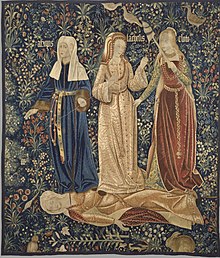Lachesis
| Part of a series on |
| Ancient Greek religion |
|---|
 |

Lachesis (
Origin
According to
Namesake
Lachesis is a genus of pit vipers sometimes called bushmasters.[4] It includes the largest venomous snake in the Western Hemisphere.
References
- ISBN 978-0-86534-587-4. Retrieved 29 July 2013.
- ISBN 978-0-316-34114-1
- . Cantos33.weebly.com. Retrieved 2012-10-03.
- ISBN 978-1-4214-0135-5. ("Lachesis", p. 149).
Further reading
- Thomas Blisniewski: Kinder der dunkelen Nacht. Die Ikonographie der Parzen vom späten Mittelalter bis zum späten XVIII. Jahrhundert. Dissertation Cologne 1992. Berlin 1992.
